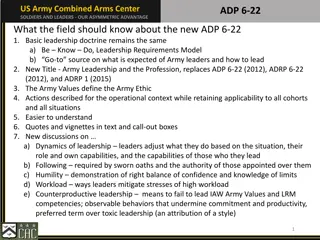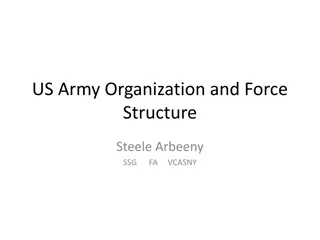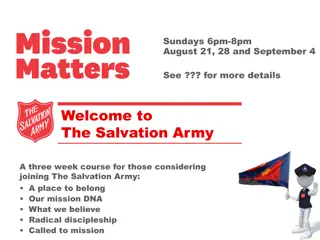C-WAM: U.S. Army Operational Wargaming Analysis Model
The Center for Army Analysis Wargame Analysis Model (C-WAM) is a manual, computer-aided, time-step, force-on-force simulation methodology used by the U.S. Army to analyze campaign-level operational courses of action. Developed over ten years, C-WAM provides a detailed understanding of theater backdrops, engaged forces, and operational concepts before encoding them into high-resolution models. It focuses on Phase II (Seize the Initiative) and Phase III (Dominate) of operational campaigns, evaluating joint capabilities and exploring the impacts of emerging technologies.
Download Presentation

Please find below an Image/Link to download the presentation.
The content on the website is provided AS IS for your information and personal use only. It may not be sold, licensed, or shared on other websites without obtaining consent from the author.If you encounter any issues during the download, it is possible that the publisher has removed the file from their server.
You are allowed to download the files provided on this website for personal or commercial use, subject to the condition that they are used lawfully. All files are the property of their respective owners.
The content on the website is provided AS IS for your information and personal use only. It may not be sold, licensed, or shared on other websites without obtaining consent from the author.
E N D
Presentation Transcript
UNCLASSIFIED U.S. ARMY U.S. ARMY Center for Army Analysis Wargame Analysis Model (C-WAM) Presentation for the MORS Wargame CoP 20 APR 16 Daniel Mahoney (703) 806-5645 Daniel.p.mahoney4.civ@mail.mil UNCLASSIFIED
C-WAM Background U.S. ARMY U.S. ARMY C-WAM development grew from the requirement for campaign analysts to more fully understand the theater backdrop, engaged forces and concept of the operation (CONOP) of a new theater campaign before coding it into CAA s high-resolution theater model: JICM The original C-WAM was very ground-centric and based on the wargame process used by the 1st Cavalry Division Plans shop Engagement with a variety of joint and sister service HQs over the years (USPACOM, USEUCOME, COMPCFLT, USEUCOM, PACAF, USAFE, SOCPAC, etc.) has greatly enhanced C-WAM s representation of joint capabilities All C-WAM updates and enhancements are vetted by the CAA Campaign Analysis (CA) division wargame team members before they are included After ten years of development, C-WAM is likely the most complete joint, operational-level wargaming system in the DoD 6 Aug 2015 2
UNCLASSIFIED C-WAM Basics U.S. ARMY U.S. ARMY The C-WAM is manual, computer aided, time-step, man-in-the-loop, force-on-force simulation methodology (C-WAM Battle Tracker System has become a necessity) The C-WAM features two (or more) opposing teams simulating combat on a map-based playing surface regulated by game controllers The Process uses aggregated tactical outcomes to drive operational level insights The Process is completely free play within the constraints of a the rules and each team s approved course of action The competing teams control assets from across the full spectrum of joint and combined forces The simulation focuses on the Phase II (Seize the Initiative) and Phase III (Dominate) portions of operational campaigns. The simulation is currently designed to execute 24 or 72 hour time steps (Nine-day and twenty-seven day time step procedures are under development). UNCLASSIFIED 6 Aug 2015 3
UNCLASSIFIED C-WAM as a Tool U.S. ARMY U.S. ARMY Uses of C-WAM: Evaluating (and comparing) campaign-level operational courses of action (COA) to determine feasibility, suitability and acceptability (e.g., Defense Planning Scenarios or COCOM OPLANS) Aiding campaign modelers in understanding the operational flow and critical events of a campaign before coding it into a high resolution computer model (e.g., JICM) Serving as a test bed to explore the potential operational-level impacts of emerging technologies (yields mainly qualitative insights) UNCLASSIFIED 6 Aug 2015 4
UNCLASSIFIED Recent C-WAM Use Examples U.S. ARMY U.S. ARMY COCOM Development Support: USPACOM OPLAN 507X Devel. Wargame 1 (Nov 13) COMPACFLT OPLAN 507X Devel. Wargame (Feb 14) USPACOM OPLAN 507X Devel. Wargame 2 (Aug 14) SOCPAC OPLAN 507X Devel. Wargame (Nov 14) USEUCOM OPLAN 4020 Devel. Wargame (Jan 16) DPS Development Support: Army G3, Scenario 6 Devel. Wargame (Jun 12) Army G3, Scenario 3.1 Devel. Wargame (May 13 / Mar 14) Army G3, Scenario 3.0 Devel. Wargame (Jul 14) Army G3/Joint Staff, Scenario 7 Devel. Wargame (Apr 15) Emerging Technology Exploration: USARPAC SCO Technology Wargame (Aug 15) Army G3, LRRDDP-GC Tech Wargame (May 16) UNCLASSIFIED 6 Aug 2015 5
UNCLASSIFIED Typical C-WAM Setup U.S. ARMY U.S. ARMY White Cell Work Area Global Reference Map Blue Team Planning Area Blue Recorder Main Theater Map Main Recorder Green Team Planning Area Red Recorder Red Team Planning Area Naval Subsurface Map AOR Detail Maps UNCLASSIFIED 6 Aug 2015 6
UNCLASSIFIED C-WAM Sequence U.S. ARMY U.S. ARMY All actions in a C-WAM turn are conceptually occurring near- simultaneously, but in practice we must step through them in a logical, linear sequence: Determine Weather 1) Cyber/Space/EW Operations 2) ISR Operations 3) Integrated Air Defense System Allocation 4) Strategic Deep Strike Missions 5) Determine Air Superiority 6) Strategic Deployment 7) Logistical Sufficiency Check 8) Naval Combat 9) Tactical Deep Strike Missions 10) Ground Combat 11) Post Combat 12) Post-turn Hot Wash 13) UNCLASSIFIED 6 Aug 2015 7
UNCLASSIFIED Step 1 Determine Weather U.S. ARMY U.S. ARMY Purpose: to estimate the impact of an AOR s natural weather patterns on a campaign There are three climate types available: Dry, Moderate, Rainy There are three weather states available: Clear, Cloudy, Storm The climate type governs the distribution of weather states The weather state effects: ISR System effectiveness Ground and Naval unit movement speed Air sortie generation (fixed wing and helo) Naval surface combat Air to ground weapons delivery Chemical weapons UNCLASSIFIED 6 Aug 2015 8
UNCLASSIFIED Step 2 Cyber/Space/EW Operations U.S. ARMY U.S. ARMY Purpose: to provide an estimate of the effects of successful cyber, space and electronic warfare (EW) operations on a campaign The process assumes that the impacts of myriad tactical level operations across the electronic domains can be aggregated into point estimates of the theater-wide effect A successful operation is defined as a disruption of the opposition s efforts in a domain (cyber, space or EW) The methodology assumes that a force is minimally effected by a disruption in any one electronic domain but that the impact grows rapidly as additional domains are effected: Disruption in any one domain produces a tactical effect; in any two an operational effect and in all three a strategic effect Study leads must consult with experts to determine the correct disruption probability estimates on each side In force-on-force situations (e.g., ground combat) the overall impact of electronic domain degrades is determined by the net of the two side s degrade levels UNCLASSIFIED 6 Aug 2015 9
UNCLASSIFIED Step 3 Theater ISR Operations U.S. ARMY U.S. ARMY Purpose: to generate an acceptable estimate of each side s ability to develop targeting level data on the opponents forces and critical installations The ISR methodology is a compromise between the perfect knowledge (single map) and zero-base knowledge (multiple map) wargaming systems The base ISR assumption is that a single, point-estimate can be made for the effectiveness of the ISR system across the ISR Can have a unique detection probability for the ground, maritime and air domains The detection probabilities can change each game turn as ISR capacity increases or decreases The base detection probabilities are effected by the weather state The umpire can override the system detection routine to account for special situations (e.g., EMCON operations, localized detection arrays) Players can see all forces deployed in the AOR (except subs) but can only act on those targeted by the ISR system All units in contact are automatically targeted Partisans and SOF strategic reconnaissance (SR) teams can provide real- time targeting data Fixed facilities are assumed to be known and pre-targeted UNCLASSIFIED 6 Aug 2015 10
UNCLASSIFIED Step 4 Integrated Air Defense System (IADS) Allocation U.S. ARMY U.S. ARMY Purpose: to provide a means of pre-assigning strategic SAM coverage within the Battle Tracker system to expedite deep strike operations Strategic air defense systems are a critical enabler of all theater operations and as such are also primary targets Many nations (e.g., Russia and China) have extensive IADS The proliferation of threat AD systems provides for complex coverage which must be realistically assigned Working through the coverage dynamically each turn bogs down the wargame flow unacceptably Making IADS allocation a formal turn sequence step allows it to be done in detail once up front, and then adjusted at the margin thereafter Detailed IADs coverage assignment is limited to long range and key medium range SAM systems and includes: Mutual support between AD units Area coverage of ground units at the division and corps level Coverage of airbases and key installations UNCLASSIFIED 6 Aug 2015 11
UNCLASSIFIED Step 5 Strategic Deep Strike Operations U.S. ARMY U.S. ARMY Purpose: to provide an estimate of the impact of deep strikes against key strategic systems and infrastructure on a campaign Deep strike operations are segregated into two categories based on entity targeted: strategic and tactical Strategic targets have theater-wide influence (e.g. APODS, SPODS, Strat IADS, fuel depots) Tactical targets are typically ground units, ships and individual aircraft Deep strikes on strategic targets are executed early in the turn because they can effect multiple aspects of the joint fight Deep strikes are typically made with a variety of penetrators including tactical ballistic missiles, cruise missiles, stand-off weapons, fixed wing aircraft and rocket artillery Deep strike penetrators must potentially pass through combat air patrol (CAP) and IADS gates enroute to their targets. These gates have the ability to reduce the effectiveness of the deep strikes The effects of deep strikes are adjudicated using the C-WAM Deep Strike Table Targeting latency impacts strike effectiveness (real-time vs. lag-time) Munition precision impacts strike effectiveness (precision vs non-precision) UNCLASSIFIED 6 Aug 2015 12
UNCLASSIFIED Step 6 Determine Air Superiority U.S. ARMY U.S. ARMY Purpose: to determine control of airspace throughout the AOR and thus establish the dynamics of theater deep strikes and air-ground ops The Air Superiority step has three sub steps: Generate the air tasking order (ATO) for each command Assign combat air patrol (CAP) flights to specific air regions Execute air-air combat to decide control of disputed air regions During ATO generation, commanders assign available sorties to one of five mission types: Air-air (CAP), Air Interdiction (AI), Close Air Support (CAS), Escort and SEAD. This process is Battle Tracker assisted. During CAP assignment, commanders physically place CAP markers (4-ship, 3-ship or 2-ship) on the map to cover desired air regions The CAP markers establish the instantaneous sortie in an air region In places where competitive sides have collocated CAP markers, local air superiority is determined by the C-WAM air-air combat process. Air breathing strike penetrators (CMs, FW aircraft, etc.) may attack through enemy controlled airspace but they are subject to potential loss through a CAP gate . The negative effects of a CAP gate can be mitigated by assigning escort sorties to AI packages or decoy missiles to CM salvos UNCLASSIFIED 6 Aug 2015 13
UNCLASSIFIED Step 7 Strategic Deployment U.S. ARMY U.S. ARMY Purpose: to provide an estimate for the coordination, vulnerability and time-distance issues associated with the arrival of new forces into a theater over time During this step forces entering the AOR from outside of the theater are arrived at assigned sea and air ports and of debarkation (SPODs & APODs) in accordance with their deployment timelines Arriving forces must go through a formal reception, staging, integration and onward movement (RSOI) process (2-3 days) A&S PODs may be degraded by strategic deep strikes (Step 5) which can in turn delay the RSOI process Forces can be targeted at their PODs as they are going through RSOI Degraded PODs may conduct repairs and recover over time UNCLASSIFIED 6 Aug 2015 14
UNCLASSIFIED Step 8 Logistical Sufficiency Check U.S. ARMY U.S. ARMY Purpose: to provide a rudimentary estimate for the logistical supportability of a campaign (ground ops) and provide for the theater resupply of critical high-value, low density munitions Ground campaigns are heavily dependent on their lines of communications (LoC), especially when on the offensive If the size of a ground force operating along a LOC is too large for the LOC s throughput capacity then the combat potential of the force will be necessarily diminished. Bad weather can degrade a previously sufficient LOC Enemy action can interdict a LOC Combat reversals can force additional units onto a nearly saturated LOC The Logistical Sufficiency step is also the place in the game where a study lead may decide to allow for the strategic level resupply of key weapons (AMRAAM, Patriot, etc.) from the world wide inventory if theater stocks become depleted UNCLASSIFIED 6 Aug 2015 15
UNCLASSIFIED Step 9 Naval Combat U.S. ARMY U.S. ARMY Purpose: to provide an estimate of the nature of theater maritime operations and their impact on the campaign C-WAM naval operations occur in three domains: air, surface and subsurface Naval combatants are represented at the individual ship or boat level Air and surface operations are tracked in the open on the main theater map. Subsurface operations are tracked on a separate, sequestered map Naval operations follow a move-shoot, move-shoot format (atk then def) The naval combat step covers the full spectrum of maritime operations: Air to surface Surface to surface Surface to subsurface (and subsurface to surface) Subsurface to subsurface Maritime Patrol Aircraft (MPA) Long range land attack Naval mines Naval munitions loadouts (and consumption) are tracked for each ship UNCLASSIFIED 6 Aug 2015 16
UNCLASSIFIED Step 10 Tactical Deep Strikes U.S. ARMY U.S. ARMY Purpose: provide an estimate of the ability of deep fires against ground forces to shape the ground war at the operational level Tactical deep strikes follow the same procedures as strategic deep strikes except that they are conducted against tactical ground units Such strikes may be executed by any deep strike system: TBMs, CMs, long range artillery (LRA), and FW aircraft All strike packets are potentially subject to CAP and IADS gates depending on local air superiority, air defense laydown and munitions type CMs and standoff weapons (SOWs) may be launched from outside of intercept range All LR&MR IADS may fire twice per turn once during the strategic strike turn and once during the defense of ground units Tactical deep strikes are usually essential to setting the conditions for success during the Step 11 Ground Combat step UNCLASSIFIED 6 Aug 2015 17
UNCLASSIFIED Step 11 Ground Combat U.S. ARMY U.S. ARMY Purpose: to provide an estimate of the nature of theater ground operations and their impact on the campaign C-WAM ground operations are mainly conducted at the brigade level Ground operations follow the move-shoot, move-shoot format The ground combat step covers the full spectrum of ground ops: Atk vs hasty, prepared or fortified defenses Attack geometry matters (front, flank, rear) Force multipliers available (CAS, minefields, etc.) Vertical envelopment Amphibious operations Joint-fires only attacks Ground battle adjudicator produces attrition and movement results Covering force, strongpoint passage of lines actions represented Chemical and tactical weapons effects (along with decon) available Ground units below 50% strength can defend only; below 30% removed Maintenance and medical reconstitution effects included (default 5% per day) UNCLASSIFIED 6 Aug 2015 18
UNCLASSIFIED Step 12 Post Combat U.S. ARMY U.S. ARMY Purpose: to provide an estimate of the indirect impacts of the campaign on the AOR C-WAM includes provisions to account for several non-combat situations Refugee Flows Impact on LoCs Refugee control requirements Stabilization Requirements Generalized strategic consumption of combat assets Security of high value & WMD assets Timing and strategic consumption of combat assets UNCLASSIFIED 6 Aug 2015 19
UNCLASSIFIED Step 13 Post Turn Hot Wash U.S. ARMY U.S. ARMY Purpose: to capture critical events and insights uncovered during the current game turn Quick review of the turn Typically conducted by the Study Director Beginning of the analytic process UNCLASSIFIED 6 Aug 2015 20























